The cost of building a new garage has risen in the last few years. Naturally, building costs vary by size, type, and complexity, so in this article, we’ll cover the cost of building a garage across various regions in the UK.
To give you an accurate view of costs, we’ll also compare four different types of garages: a single garage with a flat roof, a single garage with a pitched roof, a double garage with a flat roof, and a double garage with a pitched roof.
Building A Garage Construction Cost Calculations
In our calculations, we applied a consistent methodology across different regions. The cost comparisons are based on the garage being an extension appended to an existing dwelling, not building a new detached structure.
The typical sizes of garages in the UK are:
- Single – 10 x 18 feet (3m × 5.5m, with a gross external area of 16.5m2)
- Double – 18 x 18 feet (5.5m × 6m, with a gross external area of 33m2)
We have used both of these measurements to calculate the costs in this article.
In terms of build specification when using our BuildPartner pricing tool, our pricing calculator gives you three broad options (which can be revised by item at a later point):
- Low spec is a basic finish; e.g. Leyland, Everest, Wickes.
- Mid spec is a standard finish; e.g. Dulux, Hamilton, Slim Line.
- High spec is a high-spec finish; e.g. Farrow & Ball, Fine Line, Siemens.
To keep this comparison simple, we have chosen mid spec in all our cost estimations. In addition to this, we have also provided three different benchmarks to show the range you can expect amongst different contractors. These are:
- Low benchmark – smaller companies are generally lower cost but less specialised and with low project management function; good for low/mid-spec projects and tight budgets.
- Mid benchmark – medium-sized companies offer a balanced mix of cost-effectiveness and specialisation; good for mid-range projects for effective execution within moderate budgets.
- High benchmark – larger companies generally have a higher cost base but can handle a wide variety of specialist tasks; good for mid/high-spec projects and project management.
Cost Of Building A Single Garage With A Flat Roof
Here’s a table showing the average building costs of a single garage with a flat roof in the UK:
| Single Garage With Flat Roof | Total Average Build Cost | Average Cost Per Sq Metre | ||||
| Low Benchmark | Mid Benchmark | High Benchmark | Low Benchmark | Mid Benchmark | High Benchmark | |
| East Anglia | £22,709 | £23,234 | £26,838 | £1,376 | £1,408 | £1,627 |
| London | £26,878 | £30,055 | £32,987 | £1,629 | £1,821 | £1,999 |
| Midlands | £22,185 | £24,202 | £26,219 | £1,345 | £1,467 | £1,589 |
| North England | £21,047 | £23,948 | £25,944 | £1,276 | £1,451 | £1,572 |
| Northern Ireland | £21,378 | £22,960 | £24,873 | £1,276 | £1,392 | £1,507 |
| Scotland | £21,708 | £23,682 | £25,655 | £1,316 | £1,435 | £1,555 |
| South East | £23,835 | £26,652 | £29,252 | £1,445 | £1,615 | £1,773 |
| South West | £22,450 | £25,393 | £27,870 | £1,376 | £1,539 | £1,689 |
| Wales | £22,192 | £24,815 | £26,649 | £1,345 | £1,504 | £1,615 |
| Average | £22,709 | £24,993 | £27,365 | £1,376 | £1,515 | £1,659 |
All costs exclude VAT.
Here’s what the data shows for the cost of building a single garage with a flat roof:
- It costs 23% more to build a garage in London than in other regions.
- The minimum cost is £21,047 and the maximum cost is £32,987.
- The total average cost is £25,023, or £1,516 per square metre.
Cost Of Building A Single Garage With A Pitched Roof
Here’s a table showing the average building costs of a single garage with a pitched roof in the UK:
| Single Garage With Pitched Roof | Total Average Build Cost | Average Cost Per Sq Metre | ||||
| Low Benchmark | Mid Benchmark | High Benchmark | Low Benchmark | Mid Benchmark | High Benchmark | |
| East Anglia | £26,880 | £29,323 | £31,767 | £1,629 | £1,777 | £1,925 |
| London | £32,019 | £35,803 | £39,296 | £1,941 | £2,170 | £2,382 |
| Midlands | £26,170 | £28,549 | £30,928 | £1,586 | £1,730 | £1,874 |
| North England | £24,686 | £28,245 | £30,598 | £1,496 | £1,712 | £1,854 |
| Northern Ireland | £25,137 | £26,930 | £29,174 | £1,496 | £1,632 | £1,768 |
| Scotland | £25,588 | £27,914 | £30,240 | £1,551 | £1,692 | £1,833 |
| South East | £28,477 | £31,842 | £34,949 | £1,726 | £1,930 | £2,118 |
| South West | £26,528 | £30,056 | £32,989 | £1,629 | £1,822 | £1,999 |
| Wales | £26,176 | £29,270 | £31,497 | £1,586 | £1,774 | £1,909 |
| Average | £26,851 | £29,770 | £32,382 | £1,627 | £1,804 | £1,963 |
All costs exclude VAT.
Here’s what the data shows for the cost of building a single garage with a pitched roof:
- The minimum cost is £24,686 and the maximum cost is £39,296.
- The total average cost is £29,668, or £2,382 per square metre.
Cost Of Building A Double Garage With A Flat Roof
Here’s a table showing the average building costs of a double garage with a flat roof in the UK:
| Double Garage With Flat Roof | Total Average Build Cost | Average Cost Per Sq Metre | ||||
| Low Benchmark | Mid Benchmark | High Benchmark | Low Benchmark | Mid Benchmark | High Benchmark | |
| East Anglia | £32,488 | £35,442 | £38,395 | £1,074 | £1,172 | £1,269 |
| London | £38,620 | £43,184 | £47,397 | £1,277 | £1,428 | £1,567 |
| Midlands | £31,719 | £34,603 | £37,487 | £1,049 | £1,144 | £1,239 |
| North England | £30,039 | £34,227 | £37,079 | £993 | £1,131 | £1,226 |
| Northern Ireland | £30,532 | £32,770 | £35,501 | £1,009 | £1,083 | £1,174 |
| Scotland | £31,024 | £33,844 | £36,665 | £1,026 | £1,119 | £1,212 |
| South East | £34,126 | £38,159 | £41,882 | £1,128 | £1,261 | £1,385 |
| South West | £32,108 | £36,328 | £39,872 | £1,061 | £1,201 | £1,318 |
| Wales | £31,728 | £35,477 | £38,119 | £1,049 | £1,173 | £1,260 |
| Average | £32,487 | £36,004 | £39,155 | £1,074 | £1,190 | £1,294 |
All costs exclude VAT.
Here’s what the data shows for the cost of building a double garage with a flat roof:
- The minimum cost is £30,039 and the maximum cost is £47,397.
- The total average cost is £35,882, or £1,186 per square metre.
Cost Of Building A Double Garage With A Pitched Roof
Here’s a table showing the average building costs of a double garage with a pitched roof in the UK:
| Double Garage With Pitched Roof | Total Average Build Cost | Average Cost Per Sq Metre | ||||
| Low Benchmark | Mid Benchmark | High Benchmark | Low Benchmark | Mid Benchmark | High Benchmark | |
| East Anglia | £39,156 | £42,716 | £46,276 | £1,294 | £1,412 | £1,530 |
| London | £46,707 | £52,227 | £57,322 | £1,544 | £1,727 | £1,895 |
| Midlands | £38,076 | £41,538 | £44,999 | £1,259 | £1,373 | £1,488 |
| North England | £35,840 | £41,093 | £44,518 | £1,185 | £1,358 | £1,472 |
| Northern Ireland | £36,539 | £39,098 | £42,356 | £1,185 | £1,293 | £1,400 |
| Scotland | £37,238 | £40,624 | £44,009 | £1,231 | £1,343 | £1,455 |
| South East | £41,609 | £46,526 | £51,065 | £1,375 | £1,538 | £1,688 |
| South West | £38,620 | £43,784 | £48,056 | £1,294 | £1,447 | £1,589 |
| Wales | £38,084 | £42,585 | £45,859 | £1,259 | £1,408 | £1,516 |
| Average | £39,097 | £43,355 | £47,162 | £1,292 | £1,433 | £1,559 |
All costs exclude VAT.
Here’s what the data shows for the cost of building a single garage with a pitched roof:
- The minimum cost is £35,840 and the maximum cost is £57,322.
- The total average cost is £43,204, or £1,428 per square metre.
Summary Of The Average Cost To Build A Garage
So, how much does it cost to build a new garage in the UK? That depends largely on where you are building. If you’re building a garage in London, it will cost you an average of 23% more, whereas if you’re building in North England, it will cost you around 8% less on average.
Based on the four different types of garages covered in this article, you can expect building a garage to cost on average (when using a mid-benchmark contractor):
- Single with flat roof – £24,993, or £1,515 per square metre
- Single with pitched roof – £29,770, or £1,804 per square metre
- Double with flat roof – £36,004, or £1,190 per square metre
- Double with pitched roof – £43,355, or £1,433 per square metre
You’ll notice that the cost per square metre decreases as the project size increases due to more efficient resource utilisation and lower average costs, leading to economies of scale.
Please remember that these costs are based on appending an extension to an existing dwelling, not building a new detached structure – and all costs exclude VAT.
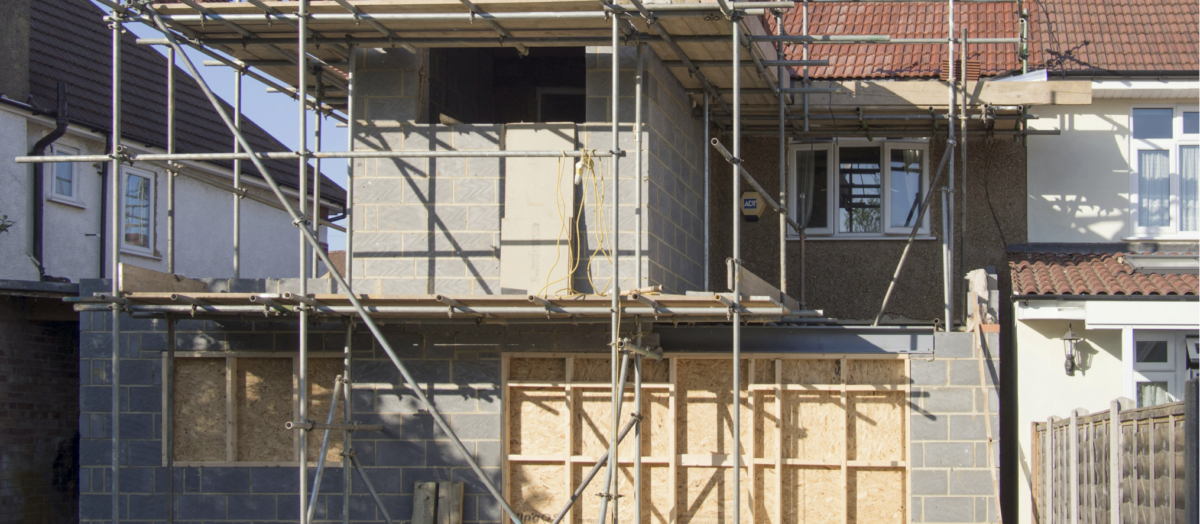
In the ever-evolving landscape of construction and home improvement, the question of building costs is perennially at the forefront of any designer’s mind—materials, labour, compliance with the latest building regulations, and VAT of course.
Naturally, the cost of building an extension varies by size, type, and complexity, so in this article, we’ll break down the costs across various regions in the UK. We’ll also look at four types of extensions:
- Single-storey rear extension
- Double-storey rear extension
- Ground-floor wrap-around extension
- Brick porch extension
We’ll explore both the total project costs and costs per square metre. At the end of the article, we’ll summarise with a comparison to give you a holistic view of the costs of building an extension.
Building An Extension Construction Cost Calculations
In our calculations, we applied a consistent methodology across different regions. The cost comparisons are based on the following:
- The roof of the extension is pitched, not flat.
- The extension is constructed out of brick/block, not a timber frame.
As far as rooms are concerned, we included the following in our calculations:
- Single-storey rear extension – dining room, utility room, WC.
- Double-storey rear extension – dining room, utility room, WC, two bedrooms, an en-suite bathroom, a storage room, small landing.
- Ground-floor wrap-around extension – dining room, utility room, WC, boot/cloakroom.
- Brick porch extension – vacant space.
If you’d like to try a demo of our pricing tool, sign up here.
Which rooms you choose ultimately affects the overall cost of the extension. If we were adding a room for a kitchen instead of a dining room in these extensions, we would need to factor in the cost of fitting a kitchen and the appliances – which would bump up the cost.
Important! To keep things simple, we’ve only included the costs to build the extension, not the costs to refurbish and remodel the existing space.
So, when somebody asks “How much does it cost to build an extension?” it depends entirely on the nature of the project.
There’s no single answer.
But by sharing with you the specifications for these examples, you’ll leave with a much clearer idea of the range and average costs. When using our BuildPartner pricing tool, our pricing calculator gives you three broad options (which can be revised by item at a later point):
- Low spec is a basic finish; e.g. Leyland, Everest, Wickes.
- Mid spec is a standard finish; e.g. Dulux, Hamilton, Slim Line.
- High spec is a high-spec finish; e.g. Farrow & Ball, Fine Line, Siemens.
To keep this comparison simple, we have chosen mid spec in all our cost estimations. In addition to this, we have also provided three different benchmarks to show the range you can expect amongst different contractors. These are:
- Low benchmark – smaller companies are generally lower cost but less specialised and with low project management function; good for low/mid-spec projects and tight budgets.
- Mid benchmark – medium-sized companies offer a balanced mix of cost-effectiveness and specialisation; good for mid-range projects for effective execution within moderate budgets.
- High benchmark – larger companies generally have a higher cost base but can handle a wide variety of specialist tasks; good for mid/high-spec projects and project management.
In short, contractor pricing varies due to factors such as expertise, location, and project intricacies.
Cost Of Building A Single-Storey Rear Extension
Here’s a table showing the average building costs of a single-storey rear extension with a gross external area of 30 square metres:
| Single-Storey Rear Extension | Total Average Build Cost | Average Cost Per Sq Metre | ||||
| Low Benchmark | Mid Benchmark | High Benchmark | Low Benchmark | Mid Benchmark | High Benchmark | |
| East Anglia | £70,600 | £77,018 | £83,436 | £2,353 | £2,567 | £2,781 |
| London | £81,986 | £92,188 | £102,408 | £2,733 | £3,073 | £3,414 |
| Midlands | £68,963 | £75,232 | £81,502 | £2,299 | £2,508 | £2,717 |
| North England | £65,568 | £74,576 | £80,790 | £2,186 | £2,486 | £2,693 |
| Northern Ireland | £66,730 | £71,528 | £77,489 | £2,186 | £2,384 | £2,583 |
| Scotland | £67,892 | £74,064 | £80,236 | £2,263 | £2,469 | £2,675 |
| South East | £74,199 | £82,968 | £91,062 | £2,473 | £2,766 | £3,035 |
| South West | £69,801 | £78,943 | £86,645 | £2,353 | £2,631 | £2,888 |
| Wales | £69,003 | £77,157 | £82,847 | £2,300 | £2,572 | £2,762 |
| Average | £70,527 | £78,186 | £85,157 | £2,350 | £2,606 | £2,839 |
All costs exclude VAT.
Here’s what the data shows for the cost of building a single-storey rear extension:
- It costs 21% more to build an extension in London than in other regions.
- The minimum cost is £65,568 and the maximum cost is £102,408.
- The total average cost is £77,957, or £2,598 per square metre.
Cost Of Building A Double-Storey Rear Extension
Here’s a table showing the average building costs of a double-storey rear extension with a gross external area of 60 square metres:
| Double-Storey Rear Extension | Total Average Build Cost | Average Cost Per Sq Metre | ||||
| Low Benchmark | Mid Benchmark | High Benchmark | Low Benchmark | Mid Benchmark | High Benchmark | |
| East Anglia | £123,085 | £134,276 | £145,465 | £1,827 | £2,238 | £2,424 |
| London | £143,207 | £160,796 | £179,281 | £2,387 | £2,680 | £2,988 |
| Midlands | £120,286 | £131,221 | £142,156 | £2,005 | £2,187 | £2,369 |
| North England | £114,540 | £130,152 | £140,998 | £1,909 | £2,169 | £2,350 |
| Northern Ireland | £116,541 | £124,952 | £135,365 | £1,909 | £2,083 | £2,256 |
| Scotland | £118,542 | £129,318 | £140,095 | £1,976 | £2,155 | £2,335 |
| South East | £129,236 | £144,509 | £158,608 | £2,154 | £2,408 | £2,643 |
| South West | £122,295 | £137,633 | £151,060 | £2,051 | £2,294 | £2,518 |
| Wales | £121,504 | £135,864 | £145,812 | £2,025 | £2,264 | £2,430 |
| Average | £ 123,113 | £136,525 | £148,760 | £2,027 | £2,275 | £2,479 |
All costs exclude VAT.
Here’s what the data shows for the cost of building a double-storey rear extension:
- The minimum cost is £114,540, and the maximum cost is £179,281.
- The total average cost is £136,132, or £2,268 per square metre.
Cost Of Building A Ground-Floor Wrap-Around Extension
Here’s a table showing the average building costs of a ground-floor wrap-around extension with a gross external area of 35 square metres:
| Ground-Floor Wrap-Around Extension | Total Average Build Cost | Average Cost Per Sq Metre | ||||
| Low Benchmark | Mid Benchmark | High Benchmark | Low Benchmark | Mid Benchmark | High Benchmark | |
| East Anglia | £84,035 | £91,675 | £99,314 | £2,334 | £2,547 | £2,759 |
| London | £97,577 | £109,621 | £122,056 | £2,710 | £3,045 | £3,390 |
| Midlands | £82,103 | £89,567 | £97,031 | £2,281 | £2,488 | £2,695 |
| North England | £78,096 | £88,792 | £96,191 | £2,169 | £2,466 | £2,672 |
| Northern Ireland | £79,458 | £85,196 | £92,295 | £2,207 | £2,367 | £2,564 |
| Scotland | £80,820 | £88,167 | £95,514 | £2,245 | £2,449 | £2,653 |
| South East | £88,296 | £98,731 | £108,363 | £2,453 | £2,743 | £3,010 |
| South West | £83,092 | £93,967 | £103,134 | £2,308 | £2,610 | £2,865 |
| Wales | £82,150 | £91,858 | £98,619 | £2,282 | £2,552 | £2,739 |
| Average | £83,959 | £93,064 | £101,391 | £2,332 | £2,585 | £2,816 |
All costs exclude VAT.
Here’s what the data shows for the cost of building a ground-floor wrap-around extension:
- The minimum cost is £78,096, and the maximum cost is £122,056.
- The total average cost is £92,804, or £2,578 per square metre.
Cost Of Building A Brick Porch
Here’s a table showing the average building costs of a brick porch with a gross external area of five square metres:
| Brick Porch | Total Average Build Cost | Average Cost Per Sq Metre | ||||
| Low Benchmark | Mid Benchmark | High Benchmark | Low Benchmark | Mid Benchmark | High Benchmark | |
| East Anglia | £5,983 | £5,984 | £7,071 | £952 | £1,197 | £1,414 |
| London | £6,917 | £7,735 | £8,489 | £1,383 | £1,547 | £1,698 |
| Midlands | £5,861 | £6,394 | £6,927 | £1,172 | £1,279 | £1,385 |
| North England | £5,606 | £6,344 | £6,873 | £1,121 | £1,269 | £1,375 |
| Northern Ireland | £5,693 | £6,116 | £6,625 | £1,121 | £1,223 | £1,325 |
| Scotland | £5,780 | £6,306 | £6,831 | £1,156 | £1,261 | £1,366 |
| South East | £6,249 | £6,987 | £7,669 | £1,250 | £1,397 | £1,534 |
| South West | £5,926 | £6,691 | £7,343 | £1,197 | £1,338 | £1,469 |
| Wales | £5,868 | £6,562 | £7,033 | £1,174 | £1,312 | £1,407 |
| Average | £5,851 | £6,569 | £7,207 | £1,170 | £1,314 | £1,441 |
All costs exclude VAT
Here’s what the data shows for the cost of building a brick porch:
- The minimum cost is £5,606, and the maximum cost is £8,489.
- The total average cost is £6,584, or £1,317 per square metre.
Summary Of The Average Cost To Build An Extension
So, how much does it cost to build an extension in the UK? Based on the four different extensions we covered, you can expect it to cost on average (when using a mid-benchmark contractor):
- Single-storey rear extension – £78,186, or £2,606 per square metre.
- Double-storey rear extension – £136,525, or £2,275 per square metre.
- Ground-floor wrap-around extension – £93,064, or £2,585 per square metre.
- Brick porch – £6,569, or £1,314 per square metre.
With the exception of a brick porch, you’ll notice that the cost per square metre decreases as the project size increases due to more efficient resource utilisation and lower average costs, leading to economies of scale.
Please remember that these costs do not include VAT.
UK Building Regulations Cost Guide 2024
- Post author By ken
- Post date February 21, 2024
- No Comments on UK Building Regulations Cost Guide 2024

The fees and costs when making an application for Building Regulations differ by local council, of which there are 317 in England, 32 in Scotland, 22 in Wales, and 11 in Northern Ireland. In this article, we’ll compare five local authorities in England – one in the North East, North West, South East, South West, and the Midlands.
We’ll also take a look at whose responsibility it is to apply for Building Regulations, the different types of Building Regulations applications, and approved documents.
What Are The Building Regulations?
In England and Wales, Building Regulations comprise 16 approved documents (ranging from A to S), and they cover the following aspects of construction:
| Building Regulations and Approved Documents | |
| Part A – Structure | Part J – Fuel |
| Part B – Fire Safety | Part K – On-site Safety |
| Part C – Contamination and damp | Part L – Conservation of Fuel and Power |
| Part D – Toxicity | Part M – Access |
| Part E – Sound | Part N – Glazing |
| Part F – Ventilation | Part O – Overheating |
| Part G – Hygiene | Part P – Electrics |
| Part H – Drainage | Part S – Infrastructure for Charging Electric Vehicles |
You can access a merged document on GOV.UK which shows the contents of each approved document. With over 1,500 pages, it’s not for the faint-hearted, though! But it is particularly useful if you need to perform a word search across all documents.
It’s important to remember that these regulations apply only to England and Wales. For Scotland and Northern Ireland, see:
These regulations are enforced by approved safety inspectors to protect people’s safety, health, and welfare in and around buildings.
The Types Of Building Regulations Approval
The three main types of Building Regulations applications are:
- Full plans applications, where documents and plans are submitted for approval
- Building notice applications, where work can be carried out without approval
- Regularisation applications, which is a retrospective application.
A full plans application is for more comprehensive construction projects like buildings and extensions, whereas a building notice application will suffice for more domestic building work and alterations. The latter is a faster process, and work can commence 48 hours after an application has been submitted (except where the work is a commercial project or close to a public sewer).
Regularisation applications are needed in instances where work has already happened but is not compliant; say, for example, a project took place in 2010, but a solicitor is requesting a completion certificate to proceed with a house purchase in 2024.
Even so, you would not be expected to comply with building regulations that have recently been introduced, such as Part S (Infrastructure for Charging Electric Vehicles). It only applies to regulations that were in place at the time.
Important! Homeowners and property owners are legally responsible for ensuring work carried out is done in accordance with Building Regulations.
The owner of the property doesn’t need to get approval if they use a contractor who is registered with a competent person scheme.
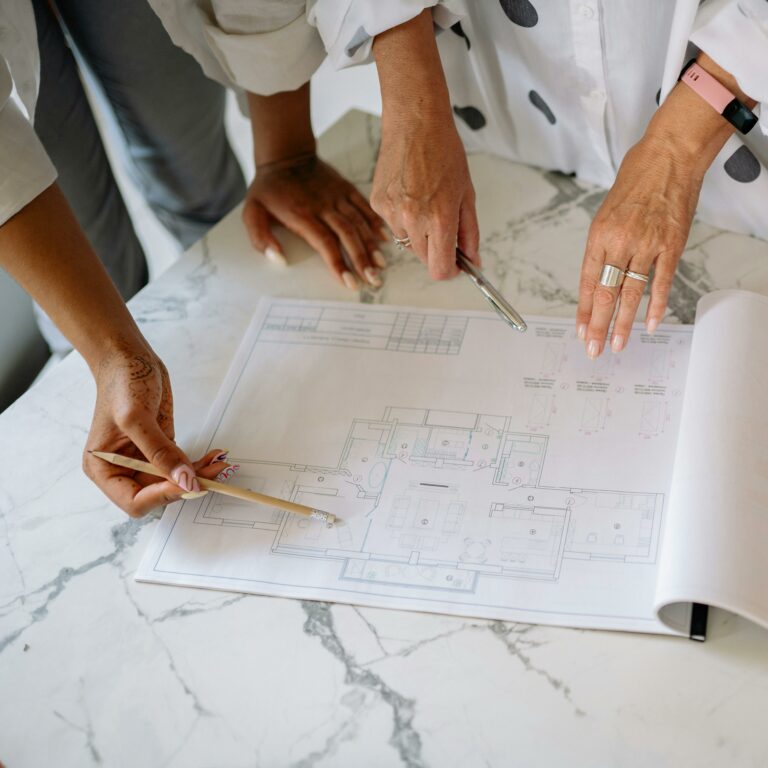
Who Can Approve Constructions?
While there is very little difference in cost, property owners now have a choice as to whether they wish to use:
- a local authority inspector employed by the local council; or
- an approved inspector from an approved building inspection company.
About one-fifth of approvals are now handled through private building control (PBCs) organisations without any involvement of the local authority. These firms must re-register with the Construction Industry Council every five years.
Any discrepancies or disagreements that cannot be resolved between the PBC and the client must be escalated to the local authority. Only they have the powers of enforcement.
Building Regulations Application Costs
Here is a table showing the cost of Building Regulations applications across five different councils. Please be mindful that Building Regulations costs are much more nuanced. For instance, there are separate costs for loft conversions, replacement windows and doors, commercial properties, and other alterations.
Here, we focus exclusively on a dwelling and an extension (between 10m2 and 40m2).
|
1 Dwelling (up to 300m2) |
Extension (10m2 to 40m2) |
||
| Local Authority | *Full Plan | Regularisation | Building Notice |
| Leeds City Council | £950.00 | £1,187.50 | £650.00 |
| North Somerset Council | £790.00 | £918.00 | £530.00 |
| Maidstone Borough Council | £1,134.00 | £1,214.22 | £809.00 |
| Preston City Council | £762.00 | Unspecified | £510.00 |
| Rutland County Council | £817.38 | £885.49 | £715.20 |
| Average Cost | £859.01 | £1,051.30 | £642.84 |
*Includes plan charge and inspection charge.
All prices shown include VAT, except in the case of regularisation where VAT is exempt.
Based on the above councils, the average cost for a full plan application for one dwelling is £860. To get an exact cost, you’ll need to find the information on your local authority’s website.
Some councils, however, are known to charge more, particularly those in Inner London. Westminster City Council sets its charges based on the value of the property. For a property that’s worth £250,000, you’ll pay an eye-watering £2,460.00 for a full plan application (and the same for a building notice charge), and it costs £3,075.00 for a regularisation application.
The higher the property value, the more you pay.
Other councils fail to display all costs on their website. For instance, Liverpool City Council displays application costs for extensions but not new-build dwellings. You will need to contact them directly or fill in an enquiry form to get the answers you need.
What’s The Difference Between Planning Permission And Building Regulations?
Many confuse the Building Regulations approval process with the planning permission approval process. In many instances, you require both.
Remember, Building Regulations is primarily concerned with ensuring that work has been carried out correctly, such as:
- the structural stability of the building;
- fire safety measures;
- the design standards for sanitary pipework and drainage; and
- the inspection and testing of electrical installations.
Planning permission, however, is concerned with the external appearance of the building, to ensure that a building is in keeping with the local environment. In essence, it’s there to avoid architectural eyesores.
Obtaining A Building Regs Certificate
Once the inspector signs off the project in accordance with Building Regulations, they will issue you with a completion certificate. The property owner must retain this (as well as a copy of the planning permission) if they ever wish to sell. Lenders and property insurers may also request a copy.
You may also need this as proof if you wish to claim VAT on the expense (where applicable).
What happens if you misplace your Building Regulations certificate? Your local authority should be able to provide you with a copy of your certificate or full plans approval notice.
What Happens Once An Application Has Been Sent?
After sending an application to a local authority or a PBC, they will get in touch with the applicant to arrange inspections at various phases of the building project to inspect the property. If the property owner has taken the decision to deviate from the approved plans (which is fairly common), they need to liaise with the local authority or PBC to discuss any implications this has.
Ensure You Comply With The Building Regulations
Suppose your local authority deems the work to be unsatisfactory. In that case, they have the power to order you to pull down the work or serve an enforcement notice to bring it up to standard (which can be served no later than 12 months after the completion of the building work).
If the owner of the property fails to comply with the notice, the local authority can undertake the work itself and recover the associated costs from the owner.
In some cases, this entails prosecution in the Magistrates’ Court where an unlimited fine is imposed (sections 35 and 35A of the Building Act 1984).
Average Building Costs Per Sq M For 2024 – A UK Guide
- Post author By ken
- Post date February 15, 2024
- No Comments on Average Building Costs Per Sq M For 2024 – A UK Guide

Building costs per square metre have reached historic highs over the last couple of years, driven by several factors which we’ll touch on in this article. More specifically, we cover the average cost of building a house per sq metre in 2024 across various regions in the UK.
Rather than providing you with an aggregated figure, we’ve mined the intel from millions of data points to show you the average costs per sq metre for East Anglia, London, the Midlands, North England, the South East, the South West, Wales, Scotland, and Northern Ireland.
Given the volatile rate of inflation and building materials prices, these estimates are constantly changing. We aim to publish a new article every six months to give you the latest insights.
Why Are House-Building Costs Rising?
We covered this at length in a previous article, but to give you a quick overview, building costs have risen sharply over the last couple of years, initially triggered by shortages in the pandemic, and then exacerbated by inflationary pressure.
But even after the effects of the pandemic abated, other economic factors have sustained the high materials prices:
- The Russia-Ukraine war has led to severe shortages of materials and fuel.
- Brexit has given rise to shipping delays, a reduction in foreign workers, and a widening trade deficit (the difference between exports and imports).
- A sustained level of high demand means builders and suppliers can charge more.
It’s doubtful that prices will return to previous levels.
Methodology For Our Construction Cost Calculations
House-building costs vary significantly depending on many factors. For instance, Purple Bricks reports that it costs on average £1,200 to £1,500 per square metre to build a house yet provides no context regarding the specification, location, or size of the dwelling. They’re basing that on a general rule of thumb.
The old adage “How long is a piece of string?” inevitably springs to mind.
In our calculations, we applied a consistent methodology across different regions. We focused on comparing a mid-range specification of a three-bedroom new-build project. The average number of bedrooms in the UK is 2.95 rooms per house, so we rounded it up to 3.
The average total floor area of a dwelling in the UK is 94m2. However, new-build designs generally exceed the average floor area of a UK home. Our data shows that a typical two-storey three-bedroom new build has a gross internal floor area (GIFA) of 110m2 – which we have based our calculation on.
Rooms included in our average costs are three bedrooms, a bathroom, a kitchen, a living room, a dining room, a cloakroom, the hallway and landing, and a dedicated boiler and storage cupboard. A garage was excluded from our calculations since only a third of UK homes have one.
In terms of build specification, our pricing calculator has three options:
· Low spec is a basic finish; e.g. Leyland, Everest, Wickes.
· Mid spec is a standard finish; e.g. Dulux, Hamilton, Slim Line.
· High spec is a high-spec finish; e.g. Farrow & Ball, Fine Line, Siemens.
For the purposes of this comparison of build costs per square metre, we have chosen mid spec.
Average House Build Costs Per Square Metre – By Region
Here’s a table showing the average building costs per square metre for a three-bedroom house in the UK (by region), where:
· Low benchmark – smaller companies are generally lower cost but less specialised and with low project management function; good for low/mid-spec projects and tight budgets.
· Mid benchmark – medium-sized companies offer a balanced mix of cost-effectiveness and specialisation; good for mid-range projects for effective execution within moderate budgets.
· High benchmark – larger companies generally have a higher cost base but can handle a wide variety of specialist tasks; good for mid/high-spec projects and project management.
Cost Per Square Metre Of Building A 3-Bedroom UK House (By Region)
| Cost Of Building A 3-Bedroom UK House (By Region) | Average Cost Per Sq Metre (excl. VAT) | ||
| Low Benchmark | Mid Benchmark | High Benchmark | |
| East Anglia | £2,386 | £2,571 | £2,765 |
| London | £2,714 | £2,973 | £3,287 |
| Midlands | £2,287 | £2,495 | £2,703 |
| North England | £2,182 | £2,477 | £2,684 |
| South East | £2,455 | £2,678 | £2,950 |
| South West | £2,340 | £2,552 | £2,809 |
| Scotland | £2,260 | £2,465 | £2,670 |
| Wales | £2,304 | £2,513 | £2,723 |
| Northern Ireland | £2,136 | £2,380 | £2,578 |
| UK Average | £2,340 | £2,567 | £2,797 |
Average Total Cost Of Building A 3-Bedroom UK House (By Region)
Here’s a table showing the average total building costs for a three-bedroom house in the UK (by region):
| Cost Of Building A 3-Bedroom UK House (By Region) | Total Average Building Cost (excl. VAT) | ||
| Low Benchmark | Mid Benchmark | High Benchmark | |
| East Anglia | £262,405 | £282,771 | £304,147 |
| London | £298,486 | £327,058 | £361,552 |
| Midlands | £251,625 | £274,500 | £297,375 |
| North England | £239,981 | £272,496 | £295,204 |
| South East | £270,005 | £294,551 | £324,474 |
| South West | £257,355 | £280,751 | £308,949 |
| Scotland | £248,545 | £271,140 | £293,736 |
| Wales | £253,439 | £276,478 | £299,518 |
| Northern Ireland | £234,931 | £261,798 | £283,614 |
| UK Average | £257,419 | £282,394 | £307,619 |
Methodology For Ground-Floor Rear Extension Costs
As above, we applied a consistent methodology across different regions when calculating the average cost per square metre for a ground-floor rear extension.
This single-storey extension has a gross internal floor area of 30m2 (which estimates suggest is the UK average) and comprises three rooms in total: an open-plan kitchen and dining room, and a living room – including the costs of refurbishments in the existing rooms.
Costs Per Square Metre Of Building A Ground-Floor Rear Extension (By Region)
Here’s a table showing the average building costs per square metre for a ground-floor rear extension in the UK (by region):
| Cost of building a Ground-Floor Rear extension (By Region) | Average Cost Per Sq Metre (excl. VAT) | ||
| Low Benchmark | Mid Benchmark | High Benchmark | |
| East Anglia | £2,491 | £2,758 | £3,024 |
| London | £2,897 | £3,269 | £3,607 |
| Midlands | £2,513 | £2,742 | £2,970 |
| North England | £2,416 | £2,723 | £2,950 |
| South East | £2,655 | £2,896 | £3,181 |
| South West | £2,559 | £2,792 | £3,064 |
| Scotland | £2,488 | £2,714 | £2,940 |
| Wales | £2,515 | £2,743 | £2,972 |
| Northern Ireland | £2,416 | £2,635 | £2,855 |
| UK Average | £2,550 | £2,808 | £3,063 |
Average Total Cost Of Building A Ground-Floor Rear Extension (By Region)
Here’s a table showing the average total building costs for a ground-floor rear extension in the UK (by region):
| Cost Of Building A Ground Floor Rear Extension (By Region) | Total Average Building Cost (excl. VAT) | ||
| Low Benchmark | Mid Benchmark | High Benchmark | |
| East Anglia | £74,742 | £82,744 | £90,745 |
| London | £86,924 | £98,079 | £108,228 |
| Midlands | £75,408 | £82,263 | £89,119 |
| North England | £72,480 | £81,694 | £88,501 |
| South East | £79,661 | £86,903 | £95,456 |
| South West | £76,792 | £83,773 | £91,935 |
| Scotland | £74,650 | £81,436 | £88,223 |
| Wales | £75,456 | £82,316 | £89,175 |
| Northern Ireland | £72,480 | £79,069 | £85,658 |
| UK Average | £76,510 | £84,253 | £91,893 |
Average Cost To Build A House In 2024
So, how much does it cost to build a new house in the UK? That depends largely on where you are building. If you’re building a house in London, the overall cost is around £327,058 (excluding VAT), whereas it’ll cost you an average of £272,496 in North England.
Bear in mind that these are averages and that significant outliers do, in fact, exist. Manchester, for instance, is situated in the Midlands (according to our geographic categorisation; we work on postcode-specific pricing). According to Statista, Manchester has the second-highest residential construction costs per square metre in the UK – second only to London.
Will UK Construction Costs Fall In 2024?
- Post author By ken
- Post date January 8, 2024
- No Comments on Will UK Construction Costs Fall In 2024?

The big question on many minds is “Will UK construction costs fall in 2024?” The construction sector faces several challenges, such as a decline in housing demand, a stagnating economy due to inflation, and climbing mortgage rates – but what about rising costs?
In this article, we’ll explore how several economic factors are impacting the build cost of UK construction projects and the outlook for 2024.
A Look Back At Historical Construction Prices
Before we dive into what the market is currently indicating, let’s take a look back at historical prices. The latest figures released by the Department for Business & Trade suggest the construction material price index decreased by 2.1% in October 2023 compared to the same month the previous year.
If you look at the last 24 months in isolation, you see a gradual decline in construction prices. However, this fall is negligible when you consider the increase we saw in 2021/22 – when prices of building materials rose more than 45% at the beginning of the Covid-19 pandemic.
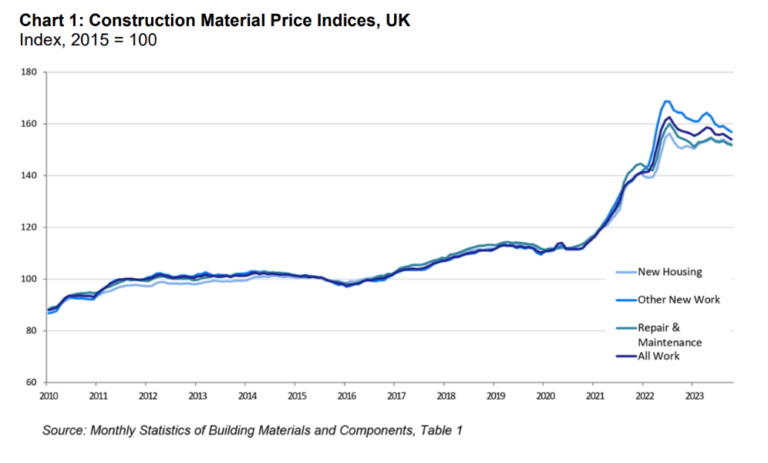
Despite a slight decline from the peak in 2022, material prices have held for the most part – even though the initial demand that triggered the spike has long since subsided. A 2.1% decline in the UK construction price index is a small shift.
Since construction output has fallen by around 7% in 2023, you might be wondering why construction material prices haven’t fallen more drastically. Economics is seldom so formulaic.
There are several factors influencing the prices of construction materials. Here are the ones having the greatest impact in the UK.
1. The Cost-of-Doing Business Crisis
We often hear that we’re in a cost-of-living crisis, but we rarely (if ever) mention that we’re in a cost-of-doing-business crisis.
Inflationary pressure has squeezed the value of the pound, and operating costs are much higher. Rising energy costs, interest rates, wages, and the cost of goods are eroding the profitability of building material suppliers.
Important! UK interest rates now seem to have reached a peak, and it’s expected that they will remain around 5.25% until 2025.
2. The Current Housing Market
Even though the sector has seen a 7% decline in the output of new-build housing as well as repair, maintenance, and improvement (RMI), the forecast for 2024 is more bullish. Glenigan predicts that construction output will grow around 12% at the start of 2024 due to a strengthening in project-starts and a pickup in housing spend.
For prices of building materials to drop, there would need to be a significant reduction in demand for those materials – but so far, construction output remains at relatively stable highs since records began in 2010. Thus, demand for build materials remains relatively high as well.
Even so, as we saw with the pandemic, in April 2020, construction output decreased by 40.1%, but that wasn’t accompanied by a drop in building materials prices – suggesting the construction market is much less reactionary to external economic factors.
3. The Brexit Impact
The cost of labour and materials have increased more steeply in the UK than in the EU, according to The Guardian. Analysis shows that, between 2015 and 2022, the cost of construction materials increased by 60%, whereas they rose only 35% in the EU.
The Guardian hasn’t made it clear which of those EU member states were included in its research, nor have they referenced which building materials this purports to. A more suitable comparison would have been between France and Germany (countries with similar GDP).
Nevertheless, one challenge that is apparent, however, is that before Brexit, 40% of construction workers in the UK came from other EU countries. The end of free movement means there is an even greater shortage of skilled workers, making it harder for companies to recruit and driving up the labour costs of construction projects.
A shortage of labour drives labour costs higher, which increases overall construction costs – subsequently reducing demand.
The Construction Industry Training Board has predicted that the industry will require an extra 225,000 workers to meet demand by 2027.
4. Government Initiatives
The total housing output in 2022 was healthy at £46.2 billion, but it was bolstered by government initiatives (Stamp Duty suspension and the Help to Buy scheme).
The Stamp Duty suspension remains in effect until 31 March 2025. The Help to Buy scheme, however, ended in March 2023. This means it’s now harder for first-time buyers to get a mortgage. They were previously able to secure a mortgage with a 5% deposit.
The dismantling of this support over the last year can be linked with the decline in construction output this year, with experts expecting a further impact in 2025 when the Stamp Duty cuts end.
An impending general election in 2024 could bring with it further stability or instability.
Labour pledges
At the Labour Party conference, Sir Keir Starmer promised to build 1.5 million homes during the next five years of parliament. He also pledged to:
- Bulldoze through the planning system in England
- Build on unused urban land (“grey belt”) to create next generations of new towns
- Increase the stamp duty for foreign buyers to disincentivise speculative overseas investment in UK property.
Conservative pledges
Back in 2021, the Conservatives set an ambitious plan to build 300,000 new homes a year, but in the year prior to the pandemic, there were 243,770 net additional dwellings.
At the Conservative Party conference, Gove reaffirmed the government’s commitment to:
- Building more homes (without offering specifics)
- Easing planning rules in cities to allow the conversion of empty retail premises
- Relaxing rules around barn, warehouse, and agricultural building conversions.
5. A Growing Reliance On Imports
One recent and alarming trend is the growing reliance on imports in the UK. Since Brexit, it’s clear that we do not yet possess the comparative advantages that our European neighbours do, such as Germany and Italy – who accounted for £2.2 and £1.3 billion of imports in 2022, respectively.
The gap between imports has more than doubled since 2015, with UK exports hardly growing in the last eight years. In 2022, the annual trade deficit widened by £3.9 billion to £15.5 billion, an increase of 34.4%. Why? Because foreign suppliers can provide commodities much cheaper than suppliers in the UK.
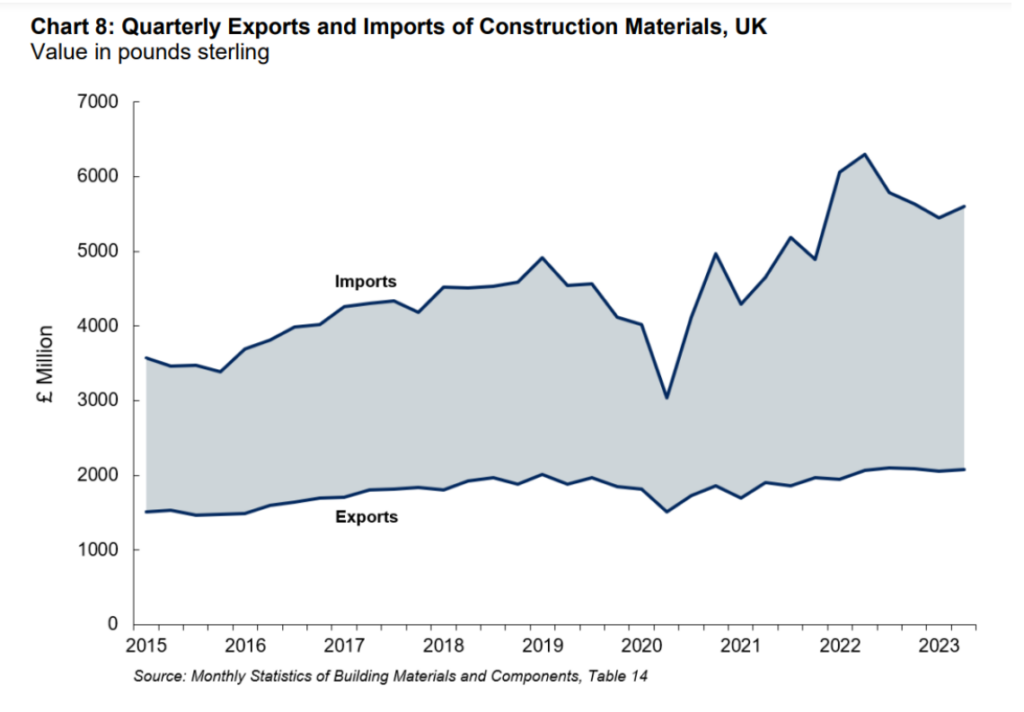
We imported £1.3 billion of sawn wood in 2022. Given the availability of land and the suitability of our climate for growing trees, it wouldn’t be hard to imagine a future in which the UK was self-reliant in timber production – leaving housebuilders (and their customers) less exposed to volatile prices and less exposed to supply chain disruptions at ports.
The UK also imported £700 million of linoleum products. The UK’s last surviving linoleum factory in Kirkcaldy, Scotland, which opened in 1847, is continuing to produce the eco-friendly and natural flooring solution (made of completely natural materials that come from renewable sources and are 100% biodegradable).
Should the UK be more independent when it comes to sourcing building materials? Self-reliance carries economic benefits as well as ecological benefits, but it’s not high on the agenda of our incumbent government.
What A Drop In Demand Of Brick Sales Tells Us
The UK market for brick sales saw a 29.1% decrease in brick deliveries in October 2023 compared to October 2022. It’s a similar pattern for concrete blocks too – a 24.2% decrease year on year. These early signs suggest that the demand for new housing is slowing.
Brick sales have dropped to their lowest level since 2010, and the downward trend looks set to continue. But that doesn’t necessarily mean to say we should expect a price decline.
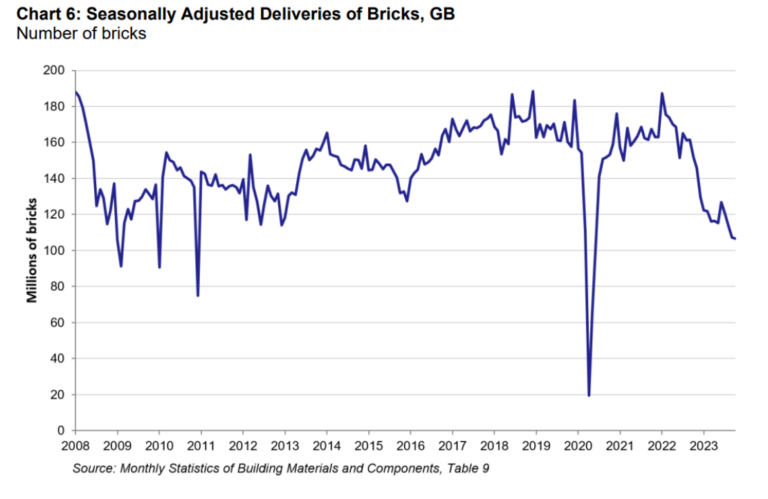
Why prices rarely come back down
Unless there is something majorly disruptive, such as an innovation that slashes the costs of raw material production, prices of building materials rarely drop back to previous levels following a prolonged increase.
The price elasticity of demand refers to the change in demand when there is a change in the price of a product. Demand is considered inelastic if demand for a good or service remains unchanged even when the price changes.
Necessities such as building materials are inelastic, luxuries are considered elastic.
If demand sustains after a price increase, suppliers have no reason to reduce their prices – because that’s the price that customers are willing to pay. The Invisible Hand of the market determines whether prices will rise or fall.
Final Word On Construction Prices In 2024
Certain markets may see a temporary drop in material costs in 2024 (should we see a decline in construction activity), but due to the several economic factors outlined – government policy, construction cost inflation, Brexit, the annual trade deficit, and the current housing market – most material costs are unlikely to return to previous levels.
The cost of doing business has reached historic highs, meaning suppliers of building materials are faced with a stark choice: charge higher prices or wind up their operations.
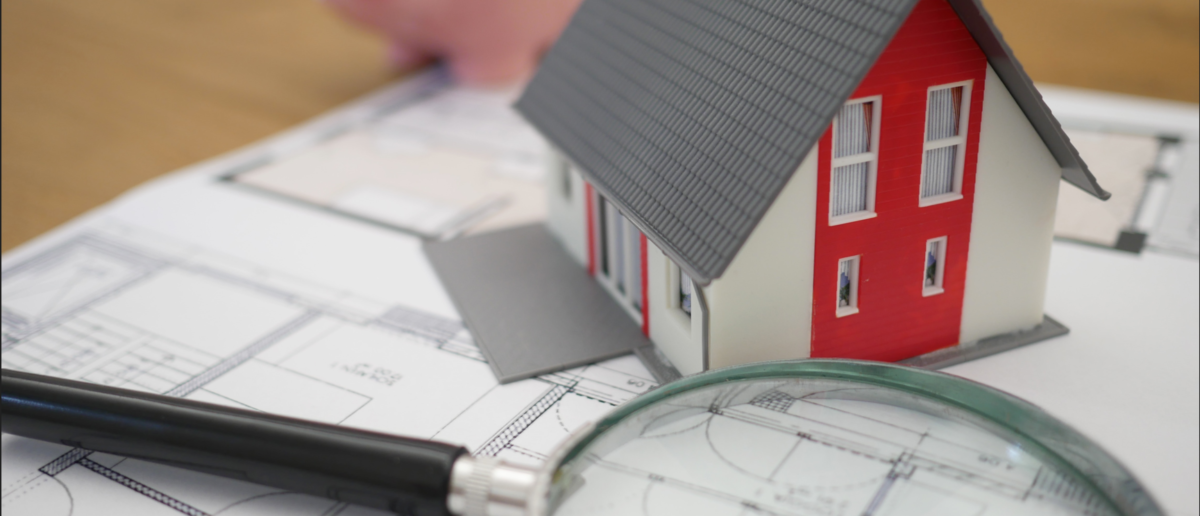
Construction costs have soared in the last few years as demand has outstripped supply, but costs are gradually stagnating and have now fallen for four consecutive months. It’s not just hard costs that are volatile but soft costs, too.
Are you familiar with the difference between hard and soft costs? We’ll discover the nuances of each in a moment.
According to a McKinsey report, 69% of construction projects exceed their budget by around 10%. There are, of course, various factors at play in this – one of which is inadequate cost planning.
Understanding the difference between hard costs and soft costs will help you bolster your cost plans and bring stability to your construction projects.
Defining Hard & Soft Costs
Hard costs are expenses that are directly related to the physical construction process, while soft costs are indirect expenses that are related to planning and management.
- Hard costs are easier to quantify because they’re tied to specific construction activities and generally make up a larger portion of the total costs of a project.
- Soft costs are harder to estimate because they’re often spread throughout the project lifecycle, and they generally make up a smaller portion of the total cost of a project.
Exceptions
Since hard costs relate to tangible aspects of a construction project, you can be forgiven for thinking that land acquisition is a hard cost – but it’s not. Most professionals consider land a soft cost because acquisition takes place prior to the scheduled works.
What about furniture, fixtures, and equipment (FF&E)?
This includes both moveable furniture and fitted furniture that can be removed without damaging the structure of the building – for example, shelving.
As for repairs and maintenance involving physical labour after the construction is complete, these are categorised as soft costs. The same goes for gardening and landscaping costs.
The Main Soft Costs In Construction
When creating your cost plan, it helps to segregate soft and hard costs. Here are some of the main soft costs that you should include. Please note that this isn’t an exhaustive list and soft costs vary greatly in their nature.
- Planning: project management, coordination, and office support.
- Legal: legal fees, planning applications, and compliance with regulations.
- Insurance: various types of insurance coverage.
- Advertising: marketing and promotional activities.
- Repairs: maintenance and unforeseen repairs during construction.
- Security: on-site security measures.
- Rentals: facilities or temporary accommodation.
- Loans and financing: interest and fees associated with project financing.
- Design fees: architectural and engineering design services.
- Land costs: acquiring and preparing the construction site.
Remember, these are costs that are indirectly associated with the construction of a project – that is, the supporting costs that enable the physical construction of a building.
The Main Hard Costs In Construction
Hard costs typically account for between 70% and 80% of total construction costs. A few examples of these are:
- Materials: raw materials such as steel, concrete, and timber.
- Labour: wages and benefits for construction workers.
- Equipment: purchase or hire of machinery and tools.
- Utilities: connection of water, drainage, electricity, gas, etc.
- Mechanical systems: HVAC, plumbing, electrical, and fire safety systems.
Now that you know the difference between the hard and soft construction costs, it’s time to work up a solution for proactively managing them, before they spiral out of control.
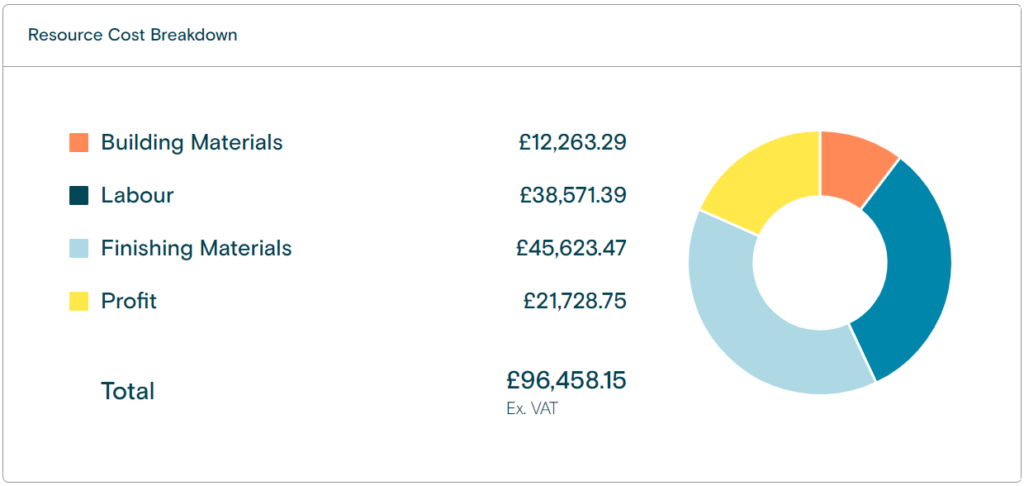
Actionable Steps For Estimating Hard & Soft Costs
Accuracy is a must if you want to come in below budget. That means no more back-of-the-fag-packet calculations. You need to be methodical in your cost planning.
1. Understand the 5 levels of Cost Estimation
The Association for the Advancement of Cost Engineering (AACE) outlines five levels of cost estimation. Every level relates to the information that’s available at the time of estimation.
- Order of magnitude estimates: when minimal design details are available, these are used to prepare rough estimates.
- Study estimates: when early design details are shared, you can gauge the project’s feasibility.
- Preliminary estimates: when initial data on materials and labour is provided.
- Definitive estimates: when more detailed design information becomes available.
- Detailed estimates: when complete information on the design, labour, and material costs is available.
It’s common for contractors to progress throughout a project’s lifecycle without iterating the cost plan. Is it any wonder construction companies overspend when the budget is based on woolly estimates?
Maybe you’ve given an indicative quote to a customer who’s taken that as concrete. Be sure to manage customer expectations at the outset and let them know the
2. Use BuildPartner Cost Planning Software
Using BuildPartner cost planning software, you can prepare a detailed estimate in a matter of minutes for hard costs, based on minimal or early design details.
As for the five levels of cost estimation mentioned above, BuildPartner enables you to prepare:
- Order of magnitude estimates through per square metre rates.
- Study estimates at the takeoff stage.
- Preliminary estimates when scheduling the work.
- Definitive estimates after specifying the itemised costs.
- Detailed estimates at the point of analysing and collating quotes.
In that regard, it’s a full end-to-end process of cost planning for hard costs.
Whatever software or platform you’re using, your cost plan must include itemised costs. Not only does this give you transparency, but it’s important for the customer too, as it builds trust.
Having an itemised cost plan gives you greater customisation options. It’s so much easier for clients and contractors alike to adjust or remove certain components to better fit their construction budget requirements.
It also reduces the risk of errors and omissions. Ever accidentally forgotten to include the cost of an important component in a quote?
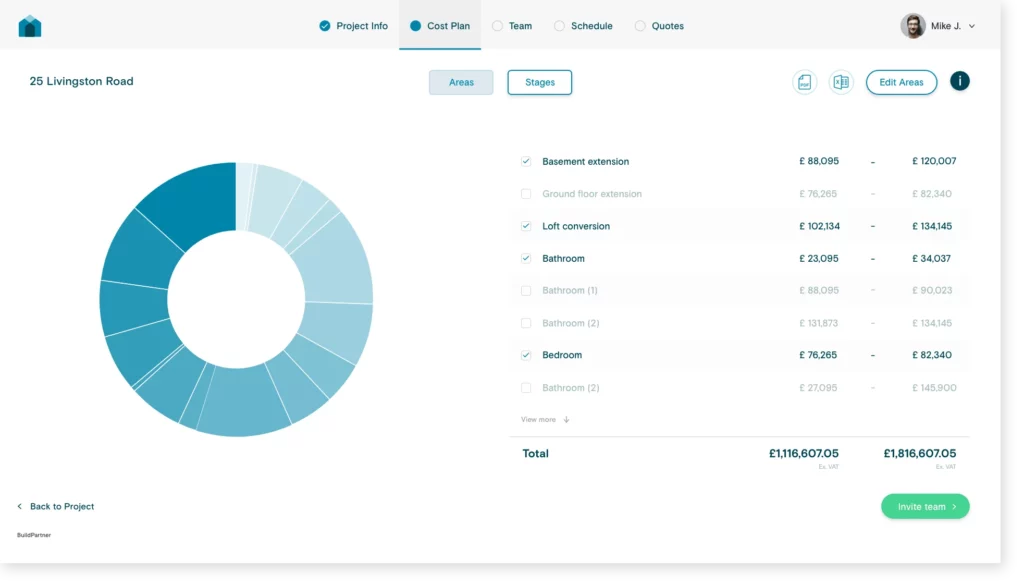
3. Bake A Contingency Plan Into The Price
Since over two-thirds of construction companies go over budget by at least 10%, it suggests that initial estimations are optimistic. It could be worse, though. Our government can scarcely manage a project like HS2 with incurring cost overruns of billions.
All manner of things can arise during project plans that contribute to overspend, such as:
- Changes to the construction schedule
- Scope or design changes
- Material price fluctuations
- Workforce availability
- Natural disasters, bad weather, or emergencies
With private firms, part of the reason for overspend is that firms are under-pricing to appear competitive and win bids.
That’s a commercial decision that only you and your team can decide, and you might be willing to risk it on smaller projects. But for the sake of accuracy, you should factor an additional 10% into more complex projects to cover any unexpected costs or delays.
Or, if you have access to historical data, use the percentage of overspend and apply that instead.
4. Track Running Costs
Cost planning isn’t a one-and-done process. Maybe you started out with a comprehensive spreadsheet, or maybe you’re paying for project management software – but are you using these tools to proactively track costs?
Ever find yourself saying, “There’s just not enough hours in the day”?
You’re too busy doing the actual doing, right?
We can all relate to this on a personal level. If we don’t check our bank statements, we quickly forget about our memberships and direct debits, and we’re oblivious to what we spend every month.
By virtue of tracking your expenses, you can act accordingly and:
- Stop buying expensive materials and source alternatives
- Identify discretionary expenses that can be cut
- Allocate funds based on strategic priorities
If you don’t track expenses, the profitability of your project is in the hands of the gods.
Final Word On Hard Vs Soft Costs
The success of any construction project hinges on the management of hard and soft costs. When a project’s stakeholders have full visibility of costs, it gives them greater control over the project’s outcome, to ensure that the vision translates into the desired outcome.
Frequently Asked Questions About Hard And Soft Costs
Here are a few questions that will provide some insight into hard and soft costs in construction.
How much contingency should a building project have?
The propensity to overestimate or underestimate a quotation varies by company, and the specific percentage depends on the complexity of the project. Those with access to historic data should take an average percentage of their previous overspend for similar projects. A general rule of thumb is around 10%.
What is cost planning in building?
Cost planning in construction is the process of estimating, managing, and controlling the costs. Those companies that adopt rigorous cost planning practices are more apt to stay on budget and within scope of a project.
What are fixed costs and variable costs in construction?
Fixed costs are constant regardless of the project’s scope or output, and they’re typically incurred before or throughout the construction process. Some of the main fixed costs in construction are salaried workers, office rent, and vehicle repayments.
Variable costs fluctuate as the project’s size or complexity grows and decrease as the project scales down. Examples of variable costs include materials, waste disposal costs, and subcontractor costs.
7 Tips For Winning More Construction Bids In 2024
- Post author By ken
- Post date December 6, 2023
- No Comments on 7 Tips For Winning More Construction Bids In 2024

It’s frustrating when you invest a bucket-load of time into bidding for a construction contract, only to never hear from the client again. But with the UK construction industry expected to bounce back and grow 12% in 2024 – according to Glenigan – there will be more projects up for grabs.
Even so, winning construction bids isn’t just a simple numbers game that involves bidding on as many projects as possible. Those who do wind up stretched and committing to projects outside of their niche.
Do you want to win repeat business from those who aren’t your ideal customers? Of course not.
Here are seven tips to win construction bids with the right clients.
1. Find the Right Projects
Just like the client, you need selection criteria too. It works both ways. So, how do you know what to look for when choosing the right projects to submit a bid for?
For starters, a construction project should be profitable. You can expect some negotiation further down the line, but if the numbers don’t stack up at the outset, it’s time to move on.
You should also spend time bidding on jobs you have more chance of winning. If a contract requires a firm to have certain trade characteristics and capabilities, you should evaluate this versus your organisation. Think about whether you meet the specifications for:
- Team size and capacity
- Accreditation and certification
- Legal compliance
- Sustainability practices
- Financial stability (large firms may request a D&B credit report)
If you find yourself bidding on every project, you’ll be engaged in work that’s less suited to your capabilities. You’ll end up trapped in a vicious cycle, winning repeat business from those same customers.
Focus on your niche – weed out the rest.
2. Know Your Bid-Hit Ratio
Your bid-hit ratio is a calculation of your successful projects versus the amount of bids you’ve submitted. If you’ve submitted 36 bids and won four, your bid-hit ratio is 9:1. That means for every ten bids you submit, you win one.
Go a step further and carry out an in-depth analysis. Break the bids up into categories like public sector and private sector contracts, building type (extensions, new builds, renovations), location, and contract value (<£5,000, >£,5,000).
With this information, you may discover that your bid-hit ratio is much stronger for smaller private contracts, particularly extensions.
3. Prepare An Accurate Estimate
Your cost planning is the foundation of your bid. Some clients will scrutinise the itemised costs, and they’ll use this as a basis for comparison with other contractors.
Have you included everything in your breakdown?
Missing items off a quotation or inputting inaccurate measurements leads to inaccuracies that will reflect unfavourably on you.
Submitting an accurate bid has never been easier through the use of cost planning software.
For instance, with BuildPartner cost planning software, you can:
- Generate instant comparable quotes of different specifications
- Automatically compile a schedule of works with a visual timeline
- Filter out inappropriate clients at little cost with a quick, accurate cost plan
- Make sure measurements are accurate and cut out errors
- Ensure no items are missed out with detailed and complete templates
- Provide accurate pricing with project-specific rates and live material feeds
- See where you are in the market with accurate averages in your area
All of this brings an unparalleled level of transparency that is welcomed by both parties. If you’re not using cost planning software, your bids will likely drown in a sea of others

4. Follow Up With Clients
So, you’ve spent a tonne of time preparing your bid, but nobody has contacted you to let you know if you’ve been successful.
That doesn’t mean you can’t reach out to them.
You don’t need to go sending passive-aggressive emails asking why you’ve not heard back. You should, however, engage with them politely and request an update on the status of your bid. Even if you’re unsuccessful, it’s an opportunity to glean some feedback from them.
5. Get Feedback (And Implement It)
Next to winning a contract, the next best thing you can gain is valuable feedback when you’re unsuccessful.
If you walk away from a tender without feedback, you do so empty-handed.
We don’t always know what the weaknesses are in our pitch, and we rely on the honesty of others to share that information.
Some clients will be happy to tell you how you measured up versus the competition – whether you were priced too high or too low, or if there were any other sticking points.
Tip! In your parting email or conversation, thank the client for their time and be sure to express your interest in working with them should things not work out with the awarded contractor. In doing so, you’re strategically pushing your way to the front of the queue and positioning yourself as a contingency.
Don’t take it personally if you don’t hear back. Some clients might just be shopping your number and weighing up the bids of others. If you suspect someone is wasting your time, don’t waste any more time engaging them.
6. Write Detailed Proposals
If you write generic proposals or proposal templates, they’ll land on the clients’ slush pile, never to see daylight again. Each bid proposal should address the specifics of that particular job.
You might think that the old copy-and-paste method will save you many hours, but the reality is that it’s harming your bid-hit ratio.
A client can spot a pre-made proposal a mile off because they fail to connect with their specific needs. The can also sniff out what’s been auto-generated by ChatGPT and Google Bard as it’s often saturated with hyperbole, wooden language, and Americanisms.
Do your homework.
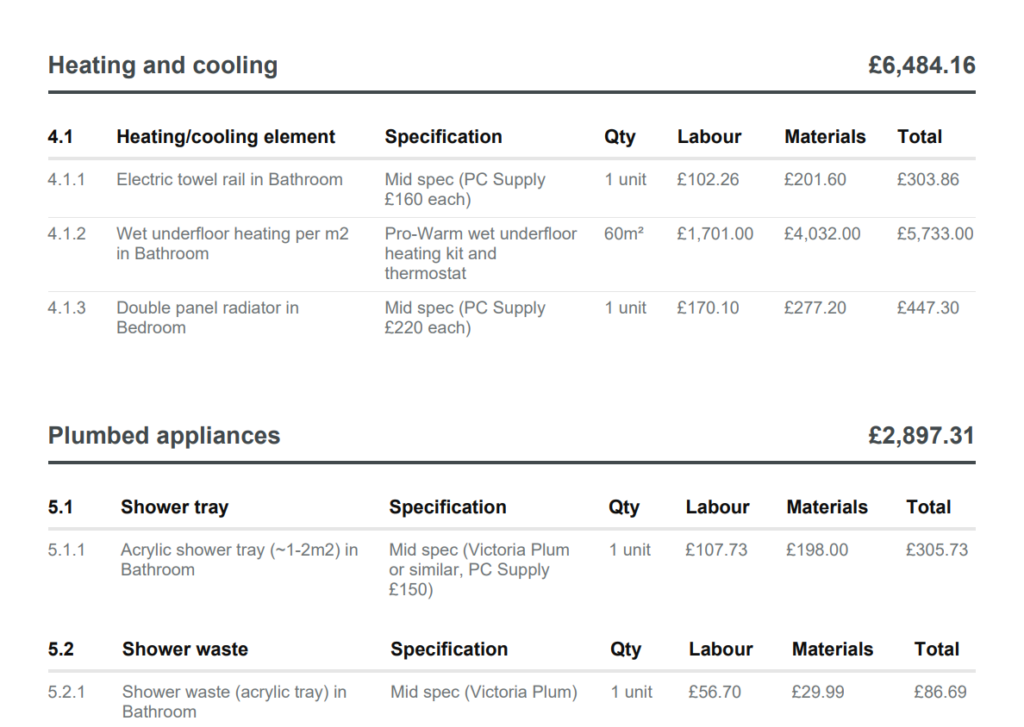
7. The Early Bird Gets The Worm
More often than not, a deadline will be specified, but that doesn’t mean the client isn’t actively assessing proposals in the interim.
You don’t have all the time in the world to submit your bid. Those who submit later on in the construction bidding process have to work harder to compete for the client’s attention and stand out from the crowd.
The anchoring bias is a psychological bias towards the first piece of information we are given about a topic. Our early learnings influence our opinions after that.
So, not only is it more likely that your bid will be reviewed when submitted earlier, but your bid will also be regarded as an authority or benchmark.
Why Do I Keep Losing Construction Bids?
If you’re receiving knockback after knockback, there’s likely a fundamental reason that’s preventing clients from awarding you the work. Stop to consider if:
- You didn’t understand the scope of the project
- The price wasn’t right
- You didn’t explicitly detail your costs
- You didn’t showcase your experience
- Your testimonials and evidence of past projects weren’t unsatisfactory
- You were missing documents and information
- You were late in submitting
- You don’t use the right tools
Price is often the deciding factor, but don’t sell yourself short. After all, if you are successful in your bid with a low price, your client will expect similar prices for future work. Are you prepared to keep winning business that underpays you?
Frequently Asked Questions On Winning Construction Bids
Here are some frequently asked questions on winning construction bids.
What evaluation criteria are used to assess construction bids?
Firms use lots of criteria when deciding which construction business to carry out their project. Professional organisations use a scoring system that analyses technical capabilities, price, quality, financial stability, compliance with requirements, sustainability credentials, track record of construction management, and the scheduled timeliness of the project plan.
What pricing strategy can I use for construction tenders?
There are many pricing strategies you can employ to arrive at your final figure. It’s important to be rigorous in your approach as your bid could be subject to scrutiny. Here are some of the main pricing strategies you can use:
- Cost-plus pricing is when you consider all costs (hard costs and soft costs), then add your margin (percentage markup) to your bid price.
- Value-based pricing is when your construction services are priced in line with what your customers are willing to pay.
- Most economically advantageous tender (MEAT) is when you offer a combination of price and quality. For example, in your bid, you may submit your lowest price (which is broadly weighted as 80% price and 20% quality), or you may wish to submit a competitive bid that reflects the highest quality (20% price and 80% quality). MEAT encourages fairness by ensuring that the cheapest suppliers don’t always win bids.
- Marginal pricing is based on the variation of output. For example, your price to build one home may attract a higher profit margin than if you were pricing for ten homes. Marginal pricing is particularly useful in expanding projects where the scope continually adjusts.
Final Word On Winning More Construction Bids In 2024
Some studies suggest that construction companies are spending as high as 22% of their operational turnover tendering for work. Tenders are fiercely competitive, and if you focus on quantity over quality, then you’ll see a margin of diminishing returns.
With each submission, your effort level will deteriorate. So you have to be selective and focus on your niche.
In an ideal world, we’d have a strong pipeline of work with our ideal customers and spend much less time submitting bids. But while we commit to a scattergun approach in bidding for contracts, that ideal remains beyond our reach.

Building Information Modelling (BIM) is more than just an advanced technological tool in the construction sector; it’s a revolution in design and management. But what exactly is BIM, and what are the key Building Information Modelling Benefits? This digital process not only creates detailed 3D representations of a building’s physical and functional attributes but also brings a plethora of advantages, from enhanced efficiency to improved collaboration. Whether you’re new to the concept or looking to deepen your understanding, this article explores the multifaceted benefits of BIM, illuminating how it’s transforming the construction industry.
How Building Information Management Software Works
Not everyone who uses BIM needs to be a technical wizard. BIMs are multi-disciplinary and collaborative in nature, and accessibility and user-friendliness for different construction professionals are paramount to ensure a successful teamwide adoption. Here are some of the main features of BIM.
3D Modelling & Visualisation
One of the most fascinating aspects of BIM software is its 3D modelling and visualisation capabilities.
It has some similarities with computer-aided designs (CAD) designs, but they differ in their approach and the information they manage.
- BIM 3D models represent a building’s geometry and also contain information about the components, materials, cost, and other related data.
- CAD is primarily a digital drafting tool that focuses on creating precise, detailed drawings and blueprints.
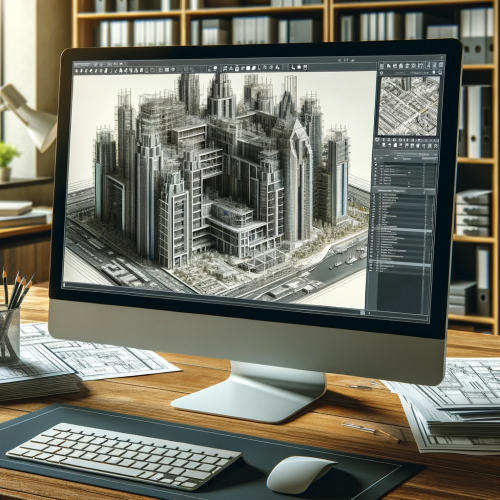
Collaboration
Collaboration between different disciplines and project team members with BIMs is made much easier due to the transparency and accessibility of a single centralised platform. Such a platform gives you access to:
- Real-time updates, such as changes to pricing and scheduling
- Documented records of project modifications
- Customisable access and permissions
- Data integrations with third-party apps
The ability to automatically detect clashes is one of the most powerful attributes of BIMs. It can save you a huge headache and prevent costly rework and delays if conflicts can be identified before any work is carried out.
Let’s say, for example, that the BIM software detects an HVAC duct that runs through the same space as a structural beam. In such a case, the duct would need to be rerouted to avoid the clash. You’d know this at the outset, before commencing any work.
Facility management
A BIM model can be used to create a “digital twin” to ensure facility managers have a complete and accurate record of a building’s assets.
In tracking the assets, a manager has access to information about their exact location, specifications, and maintenance history.
This makes it much easier to:
- Schedule maintenance
- Diagnose faults and carry out repairs
- Monitor performance and energy usage
For example, if a leak is detected, a real-time sensor will relay this back to the BIM system to plan corrective action. Using the information, a facilities manager can pinpoint potential sources of the leak and proceed with organising the required repairs.
Without a sophisticated system, such a leak could go unnoticed for some time and cause serious damage to the structural integrity of a building.
Building Information Modelling In The Public Sector
BIM compliance in accordance with the UK BIM Framework is required on all publicly funded projects in the UK.
This was formally launched in October 2019, and it has also since been incorporated into existing British standards (BS ISO 19650) – a series of standards that define BIM processes.
The government has acknowledged that digitising aspects of the construction industry is a progressive milestone that will put Britain at the forefront of global construction.
What Is The Government Construction Strategy?
The public sector plays a pivotal role in UK construction, evident in the government’s 2025 construction strategy. BIM is central to achieving goals like cost reduction, faster delivery, and environmental sustainability.
The BIM levels you need to know about
The following four levels were introduced as an industry foundation back in 2011 to help clients and suppliers understand how BIM should be used on projects.
- Level 0. Projects use only 2D computer-aided design (CAD) drafting, and any data that is exchanged is typically done via paper or print with minimal collaboration.
- Level 1. Projects use a mix of 2D and 3D CAD drafting; a common data environment is harnessed for sharing electronic data.
- Level 2. Projects use intelligent, data-rich objects in a managed 3D BIM environment; all parties can collaborate and exchange information through a common data environment (CDE).
- Level 3. Projects are fully collaborative; they use a single, shared project view for data integration that all parties can access and modify, depending on process and security controls.
Important! Since 2016, all government construction projects have attained BIM Level 2, irrespective of project size, and by the end of 2025, all projects will be Level 3.
The Future Of BIM Technology
Despite recent advances in cloud-based technology that have enabled BIM to go mainstream, things are about to get a lot more exciting thanks to technological innovations.
Virtual reality and augmented reality
In the near future, experts predict that BIM users will have access to comprehensive and clear images of their designs and the BIM ecosystem, right in front of their eyes.
Users will be able to navigate and immerse themselves in hyper-realistic worlds for greater resolution on their projects. You’ll be able to go on virtual tours to experience the scale, space, and layout of a building before construction begins.
Some suppose that the headsets of the future will be hybrids and that lenses will accommodate virtual reality and our own reality simultaneously. We’ll wear headsets throughout the day, not just when we want to view a rendering.

Artificial intelligence
Instead of manually drawing designs, we’ll soon be prompting artificial intelligence to do so on our behalf. We’ll feed the computer rules, for instance, to build according to a certain specification.
Once we have the basic infrastructure, we’ll modify it with more prompts. A design will undergo several iterations with minimal effort, and tasks that take weeks can be done in a matter of hours.
We’re already seeing 3D auto-route features being built into BIM software.
This functionality automatically routes piping while being “aware” of obstructions and objects. A user simply needs to tell the tool the connection points, and the system will do the rest.
Getting Started With Your First BIM Project
If you’ve yet to dip your toes into the world of BIM, compare the free software available at your disposal.
Many providers offer a free trial, but some offer a free version too.
Granted, these free versions have their limitations, but they give you a feel for the BIM ecosystem without having to commit to an extortionate monthly subscription.
Here are a few free versions of BIM you should check out, all of which score above four stars on Capterra for ease of use, customer service, and value for money:
When searching, check to see if the following features are included: document management, design modelling, collaboration tools, and CAD tools.
Final Word On Using BIM Software
There is a steep learning curve to using BIM, especially the technical aspects like design and 3D modelling, but there’s a plethora of training courses and YouTube tutorials to guide you.
However, there’s no substitute for getting hands-on in a live environment. New users should familiarise themselves with the user interface of their preferred software.
You’ll be surprised at how much you absorb just by fiddling around, creating views, navigating between screens, managing layers of drawings, organising documentation, inputting basic data, and creating basic 3D models like a simple room or dwelling.

As house prices have fallen for six consecutive months and prices have dropped 13.4% from their peak, it’s crucial to understand what UK House Price Predictions for 2024 mean for homeowners, landlords, and the construction industry.
According to the Office For Budget Responsibility, house prices are expected to fall a further 10% in the next year.
An impending general election also brings with it greater uncertainty. If the reduced demand for new housing and renovations continues, what will be the impact on the construction industry?
Let’s take a closer look.
The Trajectory Of The UK Housing Market
With rents at a record high and economists warning of a mortgage “time bomb”, you’re probably wondering about where the housing market is headed. But why is the UK property market in such a fragile position in the first place?
The short (and simple) answer is that it’s due to supply and demand. We aren’t building enough houses to meet the demand. When compared to the average European country, the UK has a backlog of around 4.3 million homes that are missing from the national housing market.
But the shortage has been the case for decades.
So why are things seemingly worse now?
- Climbing interest rates have made mortgages increasingly expensive
- The cost-of-living crisis and rising inflation have hit people’s spending power
- House prices have risen exponentially and wages are lagging.
In 1992, the average UK house price was little over four times the average person’s salary, now it’s around nine times the average person’s salary.
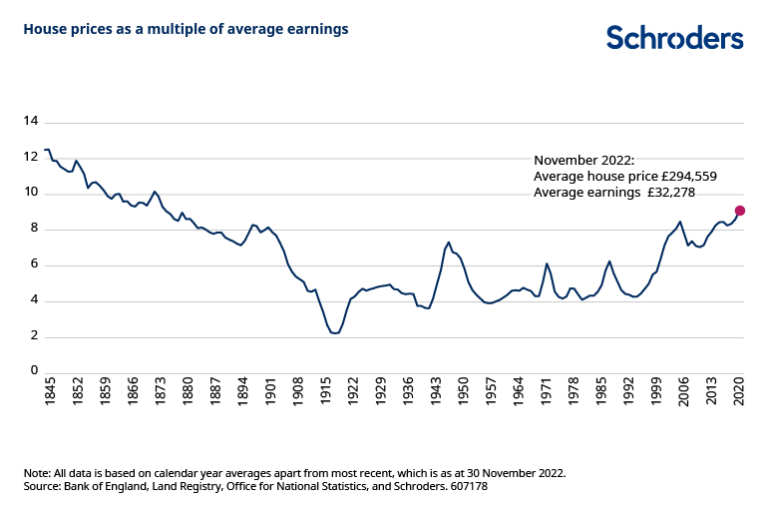
Over the last hundred years, aside from the occasional peak, the average price has stayed within the range of four to six times that of the average salary.
Since 1992, that figure has risen, preventing many would-be buyers from getting onto the property ladder and trapping them in rental accommodation.
So, where will the next decade take us?
The answer to that question may hinge on the results of the next general election.
Labour Policy Versus Conservative Policy
Labour pledges
At the Labour Party conference, Sir Keir Starmer promised to build 1.5 million homes during the next five years of parliament. He also pledged to:
- bulldoze through the planning system in England
- build on unused urban land (“grey belt”) to create next generations of new towns
- increase the stamp duty for foreign buyers to disincentivise speculative overseas investment in UK property.
Conservative pledges
Back in 2021, the Conservatives set an ambitious plan to build 300,000 new homes a year, but Michael Gove, the Secretary of State for Housing, has since backtracked, suggesting the initial target was advisory.
In the year prior to the pandemic, there were 243,770 net additional dwellings.
However, at the Conservative Party conference, Gove reaffirmed the government’s commitment to building more homes and said the party is also committed to:
- Easing planning rules in cities to allow the conversion of empty retail premises
- Relaxing rules around barn, warehouse, and agricultural building conversions.
What do the polls show?
The most recent YouGov voting intention poll shows Labour ahead at 43% and the Conservatives attracting just 27% of the vote.
The rest of the votes are distributed as follows:
- Liberal Democrats – 10%
- Reform UK – 8%
- Green Party – 7%
- Others – 5%
While there’s still a while to go, the current sentiment and the results of the recent Conservative by-election losses point towards a change in government at the next general election.
Investment into the housing market will be a key battleground to win over voters, so expect some outlandish headline promises.
The Renters Reform Bill
The Renters Reform Bill is currently under review by Parliament and is set to make the lettings system fairer for 11 million private tenants. If introduced, the Bill mandates the following:
- Periodic assured tenancies, providing more security for tenants
- Landlords must consider and cannot unreasonably refuse pets in their properties
- Landlords can’t refuse to house benefit claimants
- Tenants to give landlords two months’ notice before vacating
The Bill will also see the introduction of a new Private Rented Sector Ombudsman that will provide fair and impartial advice as well as binding resolutions.
But how would the Bill impact the housing market?
Despite making it fairer for tenants, these extra barriers put pressure on landlords in a market that’s already signalling an exodus of landlords.
If landlords and developers don’t supply the housing, who will?
“The government will miss their 300,000-homes-a-year manifesto pledge by a country mile,” according to former Housing Secretary Robert Jenrick.
Love them or hate them, the UK housing market needs private financing.
The Impact On The Construction Industry
We only have to look back at recent history, specifically the credit crunch, to see similar patterns of buying behaviour. The construction industry was one of the hardest hit by the financial crash in 2008, when house values dropped around 20%.
Many homeowners overextended themselves with 100% mortgage values and were left in negative equity.
That meant they were unable to downsize or get a better deal.
Today, around 400,000 people will see their fixed-rate mortgages end over the next few months, and they’ll be remortgaging on an average rate of 6.15% (for a two-year fixed-rate mortgage).
In September 2021, the average mortgage rate was 3.59%.
Depending on a homeowner’s loan to value, and the amount borrowed, repayments may be double or triple than what they were previously.
With mortgage repayments high and house prices declining, there is a very real danger of a “cost of ownership crisis”.
Over 50,000 people have already fallen into negative equity over the last twelve months.
A Bleak Forecast For 2024?
According to the Construction Products Association (CPA), the construction industry is virtually on the brink of a recession due to a (predicted) 7% decline in new-build housing and repair, maintenance and improvement (RMI).
Other forecasts for 2024 are more bullish. A Glenigan forecast predicts a bounce back of 12% at the start of 2024 due to a strengthening in project-starts and a pickup in housing spend.
Sceptics argue that the recovery will be postponed until rising mortgage rates cool and house prices stabilise – not to mention inflation.
There is hesitancy in the market, with many buyers adopting a wait-and-see approach, holding out for lower house prices and mortgage rates.
UK Property Market Frequently Asked Questions
Here are a few frequently asked questions regarding the UK housing market.
Are house prices dropping?
There is a consensus among economists that high mortgage rates of around 5% will remain standard for at least the next couple of years. Given the high-interest repayments, fewer buyers can afford homes, meaning it’s likely that property prices will fall.
Will there be a housing market crash in 2024?
Although there is some acceptance that house prices are taking a hit and will continue to do so, a decline of around 10% (as predicted by the Office For Budget Responsibility) hardly constitutes a crash, at least not a substantial one. A crash is usually defined as a decline of over 10% in a price index from the 52-week peak.
Will interest rates come down in 2024?
The Bank of England expects the base rate to drop to around 5% by the end of 2023, but some analysts’ market predictions point towards a rate rise to 5.75%. Regardless, Andrew Bailey, the governor of the Bank of England, warns that we should not expect interest rates to drop until we see evidence of inflation slowing. The expectation for 2024 is that interest rates will remain broadly flat.
Final Word On UK House Price Market Predictions
The UK property market and construction industry are intertwined. If the housing market were to crash, the construction industry could suffer a shock that would take years to recover from.
The housing policy of the government, both incumbent and impending, will play a large role in shielding both the housing market and the construction industry.
But lessons should be learned from previous stimulus packages.
Rishi Sunak’s stamp duty cuts during the pandemic to cushion the property market may have seemed like a good idea, but economists now argue the act pushed prices up beyond any tax savings for buyers.
The affordability and supply of housing remains the problem in need of solving. Stimulating demand will only exacerbate house price growth.

Some of the most sustainable and eco-friendly building materials in use today will surprise you. They’re not always the most expensive choice, and some will even save you money in the long run and add value to your construction project.
Fortunately, technological developments have accelerated in the construction sector over the last decade, and you have many building materials available.
While the UK government is funding grants for an additional 600,000 heat pumps in homes by 2028 as well as other decarbonising initiatives, there are voluntary steps we can take in the private sector to push us towards our collective net zero targets by 2050 – starting with making conscientious materials choices.
1. Solar Panels & Solar Tiles
Solar panels are an obvious choice, but since the spike in energy prices in 2022, there’s even more reason to design your construction project.
Around a decade or so, it was often remarked that solar panels would take around 20–25 years to pay off their initial upfront investment.
Now, estimates suggest that you could reach the break-even point in as little as 10 years for an average-sized residential property with a 4kW system – with an estimated annual saving of between £170–£565.
Commercial properties could see an even more impressive return on investment given their purchasing power.

2. Pallets & Crates
Pallets and crates are dirt cheap, and they can be repurposed for a variety of uses. Due to its varying tones, if treated properly, it can be a beautiful wood used both internally and externally. With them, you can build:
- Decking
- Sheds
- Outdoor lounge seating
- Planters
- Small picket fences
- Cladding for feature walls
If you’re using pre-loved pallets, you’ll need a team to clean, sand, stain, and seal the pallets before installation.
3. Paint That Doesn’t Contain VOC
Volatile organic compounds (VOCs) are chemicals that easily evaporate into the air and contribute to air pollution. Paints with VOCs can release chemicals into the air when the paint is applied but also for several days after application.
The VOC content in paint sold in the UK is required by law to be communicated on the product label. A product is considered to have low VOC content between 0.30% to 7.99%, and a product with minimal VOC has between 0% to 0.29%. Anything above that isn’t environmentally friendly.
Low VOC paints produce less odour and dry up to three times faster than solvent-based formulas.
4. Recycled Plastic
Plastic is a serious problem, and it accounts for over 90% of waste floating around in our oceans – around 46,000 per square mile.
Companies like Eco Plastic Wood use 100% recycled plastic to make their fence panels. The products have a 50+ year life; that’s over three times as long as wood fences, which last around 15–20 years.
You can also get 100% recycled plastic roof tiles that are designed to look like real slate.

5. Triple Glazing
Many buildings use double glazing as standard, but triple glazing is around 20–30% more energy efficient than double glazing. So even though they typically cost around 10–20% more, they’re more economically friendly as well as eco-friendly.
In terms of measuring heat retention, the U-value measures the heat transfer through a material.
- Single-glazed windows have a U-value of around 5.0W/m²k
- Double-glazed windows have a U-value of around 1.4W/m²k
- Triple-glazed windows have a U-value of around 0.9W/m²k
6. 3D Printing Components
3D printing technology is in its infancy, but some pioneering companies are using it to manufacture and produce raw materials on-site.
- The process of additive manufacturing adds successive layers of material to create products, only using what’s required.
- Subtractive manufacturing removes material to create a product.
The subtractive process of using timber involves felling a tree, limb removal, log cutting, transportation, saw milling, drying, treatment, storage, and distribution.
That’s a heck of a journey.
Green building materials used in 3D-printed homes are constructed out of concrete, thermoplastics, clay, metals, and wood chippings and sawdust.
7. Straw Bales
And he huffed, and he puffed, and – the straw house stood strong!
The load-bearing method (aka Nebraska method) involves piling bales on top of each other and creating support for the roof. They’re then plastered with earthen or lime-based materials.
Here’s a useful technical guide for straw bale construction to give you everything you need to meet UK Building Regulations.
As well as structural purposes, straw can also be used to thatch roofs and as insulation.
8. Reclaimed Wood
In the UK, five million tonnes of waste wood are generated each year, only 1.4 million tonnes of which are recycled.
The rest is burnt or landfilled.
You have the choice between using a traditional timber merchant or a reclaimed wood merchant. One of the most cost-effective solutions can be flooring.
If you can’t get your hands on reclaimed wood, your next best alternative is FSC-certified timber, where trees are harvested responsibly, so there is no net loss of forest.
9. Sheep Wool
Sheep wool is an excellent insulator, and it’s as good as rock wool and mineral wool. Thermal conductivity is measured in W/mK, where a lower value indicates a better insulator.
- Sheep wool has a thermal conductivity of 0.035 – 0.04 W/mK
- Glass wool and mineral wool have a thermal conductivity of around 0.044 W/mK
Sheep wool can be purchased in rolls or used unprocessed – the obvious drawback being that it’s more expensive.
10. Hempcrete Blocks
Hemp blocks are building blocks made of a bio-composite of hemp mixed with lime and water. It’s an alternative to traditional insulation due to its lightweight structure.
Important! It’s not used as a load-bearing structural material.
As well the hemp being a plant, the lime that is added to it undergoes carbonation, where it absorbs carbon dioxide from the air and hardens over time.
For those reasons, hempcrete has a negative carbon footprint and can sequester around 8.6 kg of CO2 per cubic foot.
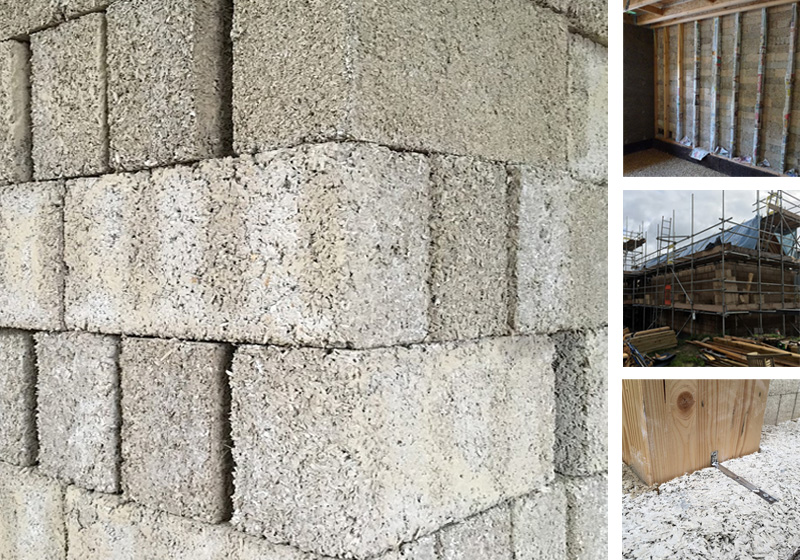
11. Mycelium
Mycelium components are organic compounds that are formed from the mycelium of fungus and organic waste. Mycelium are thin roots of fungi that run underground, and it’s super strong when dried.
This 100% natural material can be grown into specific forms for different purposes:
- Insulation. Mycelium insulation boards can be used in walls, ceilings, and roofs.
- Packaging. IKEA is currently using this as an alternative to polystyrene.
- Boards. Mycoboard (medium-density fibreboard) can be used much like MDF.
The mycelium brick is in development, but with a compressive strength of 30 psi compared to 4,000 psi of concrete, it has some way to go. But weighing 43 kg per cubic metre compared to 2,400 kg of concrete, its lightweight structure makes it an attractive development.
12. Cork
Cork trees grow very quickly, and the sustainable material used is resilient and flexible for flooring and insulation. It’s widely available and an incredibly cheap flooring solution.
However, some cork flooring comes unsealed, and while it's cheaper, you’ll need to arrange for it to be sealed.
Cork can also be used as ceiling tiles in libraries, classrooms, and offices as they reduce noise levels and provide good thermal insulation.
Bottom Line On Eco-Friendly Building Materials
There’s a huge amount of innovation in the construction industry right now, and the race is on to find new organic compounds and synthetics that will go mainstream.
Until then, though, we should look back on more traditional building techniques to make an environmental impact. Just because certain practices went out of fashion, doesn’t mean to say they’re not practical.
Straw, reclaimed wood, cork, and sheep wool are eco-friendly building materials solutions that, if used extensively, will edge us close to achieving our net zero targets.
Sustainable Building Materials FAQs
How do sustainable building materials affect the environment?
While most naturally associate eco-friendly with a reduction in carbon emissions, other benefits include a reduction in deforestation and the protection of wildlife, waste reduction, and the use of less toxic materials that are unsafe for humans.
Also, the creation of durable products that last longer reduces the need for frequent replacement and conserving resources in the long run.
What are the main considerations when designing an eco-friendly building?
Renewable and eco-friendly materials are just one consideration when planning a sustainable construction. But there are a few other energy efficiency strategies you should consider:
- Water conservation. Rainwater harvesting systems collect and reuse rainwater for potable water (when treated), such as cooking, bathing, and drinking.
- Indoor air quality. Proper ventilation systems to reduce indoor pollutants and lessen the spread of harmful bacteria and illnesses.
- Waste reduction. Implement waste sorting and disposal systems to divert waste from landfills.
- Durability. Choose durable construction materials and methods that can withstand the test of time.
- Lighting solutions. Maximise natural light while minimising the need for artificial lighting. Install energy-efficient lighting fixtures.
- Smart technology. Thermostats allow the fine-tuning of the heating schedule to preserve energy.
- Recycled material. Using recyclable materials such as recycled concrete aggregate can be used as a substitute for natural aggregates.

